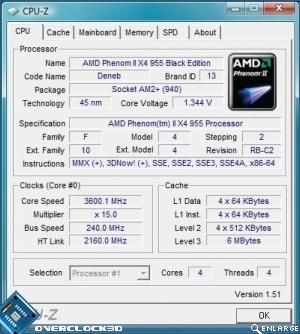Mesh Matrix II 955BE Hush Gaming PC
Noise
Â
The noise levels of the Matrix II 955BE Hush were higher than we would’ve liked. The NZXT Hush’s case fans operate very quietly however and the Akasa CPU Cooler was not particularly obnoxious either. The HEC 550W Power Supply Unit’s small 80mm fans emitted slight whines under long periods of load but the real problem child inside the computer was infact the HIS Radeon HD 4870 graphics card. Rather than using the reference dual slot cooler designed by ATI, HIS uses their own solution, which features a relatively small fan and a flower style heatsink without heatpipes. What’s worse is that the graphics card doesn’t seem to control it’s fan speed at all and as a result operates at 100% duty speed regardless of whether the system is idling on Vista desktop or whether the user is playing a game. It would be less of an issue if the system was this loud during a heavy gaming session where presumably one would have the sound cranked up high or at least be wearing a headset. During day to day general usage however, it’s very intrusive. Many may find the noise levels acceptable but personally I feel that it’s a real fly in the ointment when the system on the whole is built to an incredibly high standard. The noise levels could have easily been addressed by opting for a graphics card, which doesn’t operate at a fixed fan RPM and just as equally use a power supply with a 120mm intake fan.
Â
Â
Overclocking
Â
Â
With processor temperatures already coming close to AMD’s recommended maximum for the 955 Black Edition, we felt that it wasn’t wise to restrict our overclocking efforts to the highest safe overclock with the default voltage of 1.3500V. Despite this, we still reached a rather respectable 3.60GHz core clock speed. This was achieved by raising the CPU Multiplier from 16x to 18x. To squeeze a little more out of the CPU, we attempted lowering the CPU Multiplier to 15x and raising the base HTT clock to 240MHz, resulting in the same clock speed but with a higher Northbridge frequency of 2.160GHz. To offset the lower frequency assigned for the memory when dropping the divider, slightly more aggressive memory timings of 7-7-7-20 were applied. The HIS Radeon HD 4870 was also successfully overclocked, resulting in a core clock of 780MHz and an effective GDDR5 memory frequency of 3740MHz.
Â
Â
Â
Â
Â
Â
Â
A number of tests were run once more to see how much of a difference our tweaks made.
Â
As you can see, considerable gains have been achieved across the board. Free performance gains from a prebuilt computer. Excellent.



